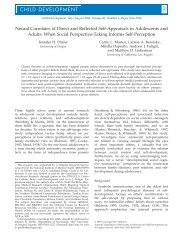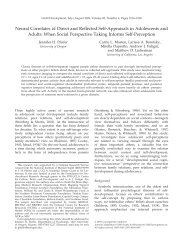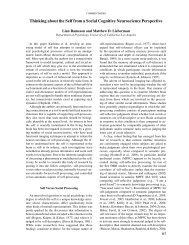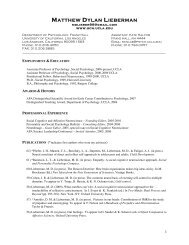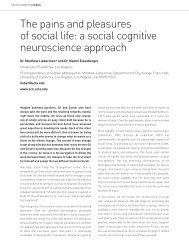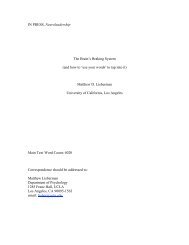In Progress – DO NOT CITE Attributional inference across cultures ...
In Progress – DO NOT CITE Attributional inference across cultures ...
In Progress – DO NOT CITE Attributional inference across cultures ...
You also want an ePaper? Increase the reach of your titles
YUMPU automatically turns print PDFs into web optimized ePapers that Google loves.
Culture, Attribution, & Automaticity<br />
24<br />
flyer and were paid five dollars for their participation. EA participants had been in the<br />
United States no more than six years (mean=2.89 years) and were from Japan (22),<br />
Taiwan (1), and China (1).<br />
Procedure<br />
The procedure was identical to study 1 except for the inferential goal given to<br />
participants and the ratings made by participants. <strong>In</strong>stead of being asked to make<br />
attributions about the target’s dispositional anxiety, participants were asked to make<br />
behavioral identification ratings of how anxious the target’s behavior was in the video<br />
clips. Participants were informed, as in study 1, that the target was discussing anxietyprovoking<br />
topics. After viewing the video clips, participants completed two behavioral<br />
identification ratings on 13-point scales. The first item, “To what extent did the person in<br />
the video clips appear to be comfortable” had endpoints anchored by “very<br />
uncomfortable” and “very comfortable” (reverse scored). The second item, “To what<br />
extent did the person in the video clips appear to be anxious” had endpoints anchored by<br />
“very relaxed” and “very anxious.” These two items were combined to form a composite<br />
(R SB = .76). Participants were shown the questions before seeing the video clips and were<br />
instructed to answer about how the target was appearing at that moment, rather than how<br />
the person might be generally in daily life.<br />
Results and Discussion<br />
To examine whether behavioral identification judgments varied by culture and<br />
cognitive load, we conducted a 2 x 2 analysis of variance with these factors. There was a<br />
main effect of cognitive load, F(1,40)=7.39, p



